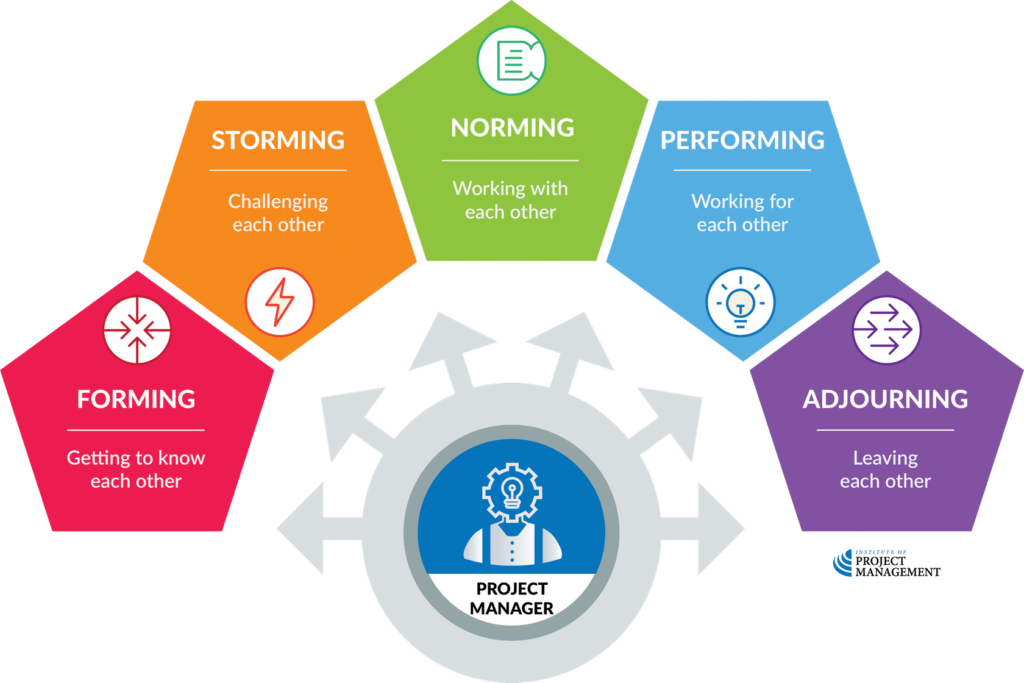The lifecycle of teams
There are five different stages of team development that are as relevant to leading projects as they are to more traditional, business-as-usual settings.
Psychologist Bruce Tuckman first came up with the memorable phrase ‘forming, storming, norming, and performing’ back in 1965.
He used it to describe the path to high performance that most teams follow, later adding a fifth stage that he called ‘adjourning’ (and others often call ‘mourning,’ maybe because it rhymes better).

STAGE 1 – Forming
Teams initially go through a ‘forming’ stage in which members are positive and polite.
Some members are anxious, as they haven’t yet worked out their place – others are simply excited about the task ahead.
As a leader, you play a dominant role at this stage: other members’ roles and responsibilities are less clear, so assist in clarifying them.
The forming stage is also usually fairly short and may only last for a single meeting at which people are introduced to one another; however, it may take a little longer to settle when establishing virtual teams.
STAGE 2 – Storming
Once reality sets in, your team moves into a ‘storming’ phase.
Your authority may be challenged as others jockey for position and their roles are clarified.
The ways of working start to be defined and, as the leader, you must be aware that some members may feel overwhelmed by how much there is to do, or they may be uncomfortable with the approach being used.
Some may react by questioning how worthwhile the project is, and some may resist taking on tasks.
This is when many teams fail, and even those who stick with the project may feel that they are on an emotional roller coaster as they try to focus on the job at hand without the support of established processes or relationships with their colleagues.
At this point, you should confirm and reinforce process and structure, defining communication methods and channels.
Work to build good relationships among team members, especially providing support to those team members who are less secure. This is also an excellent time to arrange a social or a team-building event.
Remain positive and firm in the face of challenges to your leadership or the team’s goal.
You might also like to explain the ‘forming, storming, norming, and performing’ idea so that people understand why conflict is occurring, and appreciate that things will get better in the future.
We will explore conflict management in more detail later in this Unit.
STAGE 3 – Norming
The team gradually moves into a ‘norming’ stage as workflows and relationships are established.
Team members come to respect your authority as a leader, and others show leadership in specific areas.
They also develop a stronger commitment to the project’s goals, and you start to see good progress towards them.
Now that team members know each other better, they can ask each other for help and provide constructive criticism.
As a leader, you can step back and help the team take responsibility for progress towards the goal.
There is often a prolonged overlap between storming and norming behavior; and as new project processes or phases are entered, the team may lapse into typical storming stage behavior.
Having led them out of storming once, you should be able to master the transition to norming again in less time.
STAGE 4 – Performing
When the team reaches the ‘performing’ stage – and not every team does – hard work leads directly to progress towards the shared vision of the project, supported by the structures and processes that have been set up.
Individual team members may join or leave the team without affecting the performing culture.
As a leader, you can delegate much of the work and can concentrate on developing team members.
Once the team has achieved high performance, you should aim to have as light a touch as possible. You will now be able to start focusing on stretch goals and other areas of work.
Nonetheless, it must be noted that performing is the exception rather than the rule, especially in projects.
Performing teams take years to develop – think of championship-winning sports teams.
Within the triple constraints and the tensions that otherwise exist, norming is the acceptable standard more often than not.
STAGE 5 – Adjourning
Project teams are finite by definition, and even permanent project offices may be disbanded through organizational restructuring.
The break-up of the team can be challenging for members who have developed close working relationships with other team members, particularly if their future roles or even jobs look uncertain.
The ‘adjourning’ or ‘mourning’ stage is important in reaching project, team, and personal conclusions.
When breaking up a team – even if the project was unsuccessful – take the time to celebrate its achievements.
From the team perspective, this is less about lessons learned and more about promoting a positive workplace culture for future project delivery.
Teams are formed because they can achieve far more than their individual members can on their own, and while being part of a high-performing team can be fun, it can take patience and professionalism to get to that stage.
Effective team leaders can accelerate that process and reduce the difficulties that team members experience by understanding what is needed to move through the various stages of team development.
This model suggests that the strategy you employ should be a dynamic response to the project’s circumstances and the team’s evolving state.
Once again, there is no single, cookie-cutter solution to the dilemma of team development; as with leadership style, your response depends on your being open to and aware of changes in the project environment.
Promoting teamwork
Team-building activities can vary from a five-minute agenda item in a status review meeting to an off-site, professionally facilitated experience designed to improve interpersonal relationships.
These activities are particularly valuable when project team members operate from remote locations without the benefit of face-to-face contact.
Informal communication and activities can also help build trust and establish good working relationships.
Beyond that, what are some of the specific things you can do to promote effective teamwork?
Efficient and effective communication
In Unit 4, we discussed the importance of efficient and effective communication.
In the team dynamic, this involves setting clear expectations, regularly engaging with team members throughout the project’s life, and accepting, responding to, and visibly acting on their feedback.

Enabling a culture of innovation
Beyond meeting the basic resource needs of team members and providing an appropriate physical work environment, enabling a culture of innovation is also essential if people are to rise to peak performance.
As you will recall from the first module, innovation is most simply and reliably defined as successful change, and projects, more often than not, are the vehicles we use to deliver it.
Yet, all too often, project managers fall into the trap of becoming slaves to their project plan, instead of slaves to their project objectives.
Consequently, opportunities to realize efficiencies in project delivery (or enhancements to the deliverable itself) can be missed.
Creating an environment that facilitates creativity – and a culture that encourages and rewards the same – can therefore add tremendous value to your projects. It is a value that cannot be contemplated at the planning stage.
Provide challenges
To that end, once role familiarity is achieved, it is important that team members are provided with challenges and opportunities to apply and enlarge their knowledge and skills throughout project delivery.
Giving others extended decision-making authority (within the bounds of their experience) not only enriches their work, but relieves you, the project manager, of some of your responsibility as well.
Improve trust
All of this goes to improve their trust in you as a manager; you should also make every effort to enhance trust in each other as well.
Allowing or enabling opportunities for team members to get to know each other personally will make team members more empathetic towards each other, reducing the risk of forming divisions or cliques.
Embrace failure
That sometimes means embracing failure – many of the greatest innovations are often unintended.
Breakthroughs such as the discovery of penicillin or the power of microwaves were the result of accidents.
Therefore, a willingness to tolerate setbacks on the path to success is an essential element of any project culture.




